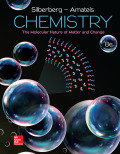
Concept explainers
(a)
Interpretation:
The percent yield of the formation of
Concept introduction:
Haber process is one of the industrial methods employed for the preparation of ammonia
Combination redox reactions are the reactions in which two or more reactants combine to form a single product. The formation of ammonia from nitrogen and hydrogen molecule is an example of a combination
(a)
Answer to Problem 4.126P
The percent yield of the formation of
Explanation of Solution
The mass of
The mass of
The mass of
Nitrogen molecule
One mole of
The molecular mass of
The formula to calculate moles of
Substitute
The formula to calculate moles of
Substitute
The molecular mass of
The formula to calculate the mass of
Substitute
The expression to calculate the percent yield of the reaction is:
Substitute
The percent yield of the formation of
(b)
Interpretation:
The moles of
Concept introduction:
The redox reaction can be classified into three types depending upon the number of reactants and products as follows:
1. Combination redox reaction
2. Decomposition redox reaction
3. Displacement redox reactions
Combination redox reactions are the reactions in which two or more reactants combine to form a single product. In displacement redox reactions, substances on both sides of the equation remain the same but the atoms exchange places in order to form the product while in decomposition reaction, one compound decomposes to form one or more product.
(b)
Answer to Problem 4.126P
The moles of
Explanation of Solution
The mass of
The mass of
The mass of
The molecular mass of
The formula to calculate moles of
Substitute
The formula to calculate moles of
Substitute
The molecular mass of
The formula to calculate moles of
Substitute
The formula to calculate moles of
Substitute
The formula to calculate moles of
Substitute
The formula to calculate moles of
Substitute
The moles of
Want to see more full solutions like this?
Chapter 4 Solutions
EBK CHEMISTRY: THE MOLECULAR NATURE OF
 ChemistryChemistryISBN:9781305957404Author:Steven S. Zumdahl, Susan A. Zumdahl, Donald J. DeCostePublisher:Cengage Learning
ChemistryChemistryISBN:9781305957404Author:Steven S. Zumdahl, Susan A. Zumdahl, Donald J. DeCostePublisher:Cengage Learning ChemistryChemistryISBN:9781259911156Author:Raymond Chang Dr., Jason Overby ProfessorPublisher:McGraw-Hill Education
ChemistryChemistryISBN:9781259911156Author:Raymond Chang Dr., Jason Overby ProfessorPublisher:McGraw-Hill Education Principles of Instrumental AnalysisChemistryISBN:9781305577213Author:Douglas A. Skoog, F. James Holler, Stanley R. CrouchPublisher:Cengage Learning
Principles of Instrumental AnalysisChemistryISBN:9781305577213Author:Douglas A. Skoog, F. James Holler, Stanley R. CrouchPublisher:Cengage Learning Organic ChemistryChemistryISBN:9780078021558Author:Janice Gorzynski Smith Dr.Publisher:McGraw-Hill Education
Organic ChemistryChemistryISBN:9780078021558Author:Janice Gorzynski Smith Dr.Publisher:McGraw-Hill Education Chemistry: Principles and ReactionsChemistryISBN:9781305079373Author:William L. Masterton, Cecile N. HurleyPublisher:Cengage Learning
Chemistry: Principles and ReactionsChemistryISBN:9781305079373Author:William L. Masterton, Cecile N. HurleyPublisher:Cengage Learning Elementary Principles of Chemical Processes, Bind...ChemistryISBN:9781118431221Author:Richard M. Felder, Ronald W. Rousseau, Lisa G. BullardPublisher:WILEY
Elementary Principles of Chemical Processes, Bind...ChemistryISBN:9781118431221Author:Richard M. Felder, Ronald W. Rousseau, Lisa G. BullardPublisher:WILEY





